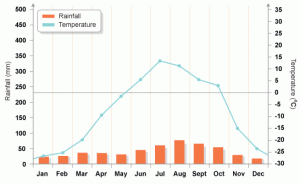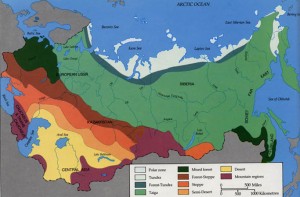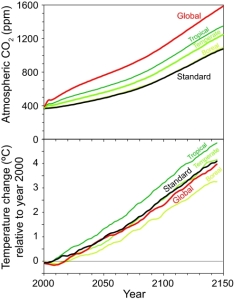The taiga is a forested biome in the far north of Russia charactarized by long, very cold winters and short summers. The Siberian taiga is heavily covered in permafrost, which is a layer of frost that never melts, regardless of the season.

This video from Planet Earth shows the importance of the taiga to the natural world both in oxygen and atmospheric regeneration. It also shows that it is densely forested and therefore very profitable, yet takes a long time for trees to grow back because the environment is so harsh.

Here are the issues facing this biome:
- This forest is huge, about the size of the continental US and the largest continuous forest on the planet.
- But its also one of the most understudied. We know much more about Canadian boreal forests. A better understanding of forest ecosystems leads to better logging practices and less impact in terms of disrupting species habitats.
- Ecological degradation of these forests includes habitat loss for animals, overuse of herbicides. Also bad infrastructure and careless road building, plus loads of heavy equipment on these roads severely degrades the ecosystem.
- There is little or poor oversight on logging practices, which stems from the Soviet era.
- Deforestation exacerbates climate change because these forests are crucial to establishing oxygen and CO2 concentrations in the atmosphere.
Overlogging Practices
- Soviet Union Policies – the branch that held jurisdiction over the logging branch – dicatated where to cut and how much – was really underfunded. They got most of their income from the logging branches that they oversaw, which gave them incentive to let them cut more forests. So the system was fundamentally set up to promote overlogging. The bad infrastructure also meant that many logs were lost, never put onto trucks, or just left to rot after they had been cut. These policies have been extremely hard to dismantle and have carried into today.
- Current – The current political landscape in Russia hasn’t really tried to dismantle these soviet policies, and if anything logging in Siberia now has even more unchecked practices.The government in the 90s attempted to pass some legislation that has actually worsened the issue. Forest management is very decentralized, there is no protection of the land, and it is all public property that can be leased for 100 years, therefore essentially allowing it to be privatized by these companies and unchecked by the government. The infrastructure is still bad and deteriorating, and the ancient logging technology is inefficient in its processing of wood. Estimates from from the 90s say that only about one third of trees cut down are acutally made into timber. These is also due to the policy that loggers are paid for what they cut down, rather than what they process or bring back. This encourages wasteful practices. It also doesn’t help that companies that are supposed to oversee conservation efforts are allowed to own shares in logging companies, thus incentivizing them to not actually regulate clear-cutting practices, similar to Soviet times.
Climate Change
- Deforestation releases CO2 into the atmosphere
- broad effects: increased CO2 dissolved in oceans, affects ocean ecosystems
- Studies show effect of deforestation have been done that predict atmospheric CO2 and the ensuing temperature increases if all forests are cut down over the next 150 years.

This study examined the effects of atmospheric CO2 and thus temperature increases on the clear-cutting of different forest ecosystems.
Solutions
One solution is reforestation, which refers to the deliberate re-planting of trees specifically in deforested areas. The problem with this is the amount of time it takes. It can take many trees in this biome up to 40 years to grow just one meter, and the permafrost further affects this growth. Also, the use of heavy logging equipment on badly built roads erodes the topsoil, which contains the bacteria essential for nitrogen fixation. With less topsoil, nitrogen fixation becomes harder, further slowing tree growth and health.
Probably the most effective solution at this point is forest protection. This involves more legislation to protect these forests with national forest like status (as in the US Forest Service), reduce corruption, increase the development of new technology and logging infrastructure so less goes to waste. Also, there needs to be some sort of incentive for loggers to be more efficient.
Sources
THE DEFORESTATION OF SIBERIA: ECONOMIC AND ENVIRONMENTAL PROBLEMS IN RUSSIAN FOREST MANAGEMENT
Combined Climate and Carbon-Cycle Effects of Large-Scale Deforestation
http://www.ncbi.nlm.nih.gov/pmc/articles/PMC1871823/
Biomes of The World